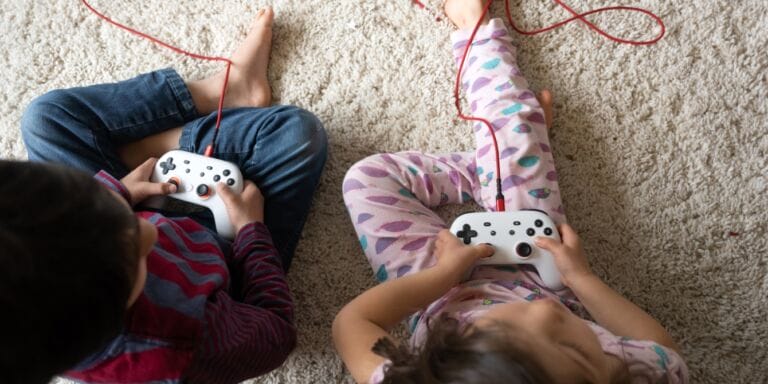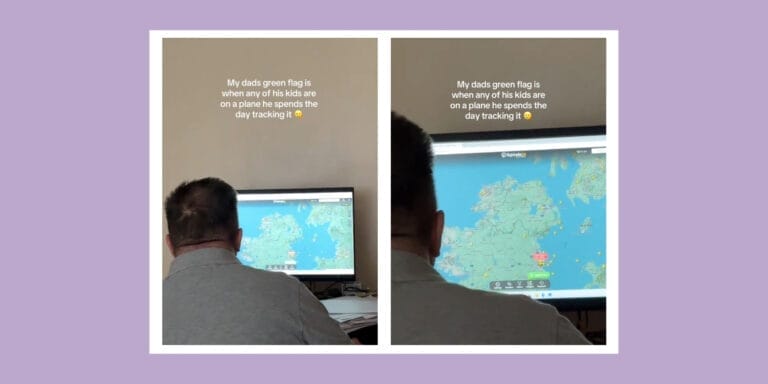Life without screens is possible—here’s how our family does it

McKinsey Jordan/Stocksy
Even an animated children’s movie can be too intense for little ones.

Table of Contents
- First, a reminder: you don’t have to start
- Second, you can stop offering screens at any time
- Identify the moments where screens start to creep in
- Invest in independent play
- It is possible to travel with children and not rely on screens
- Be discerning about what you do show them
- Finally, don’t skip FaceTime
- You are the expert when it comes to your family
We all know the moment: you’re in the grocery store and you just want to find everything on your list, or you’re making the two hour drive to Grandma and Grandpa’s house and your children are antsy and bored. These are the situations where it feels like we just want to make it to the other side, where it’s so easy to start relying on screens.
Are screens bad? As CEO and co-founder of Lovevery, I have had the opportunity to learn directly from the experts. There is a lot we know—and a lot more we don’t know—about the effects of screen time on babies and young children.
What we do know is that children under the age of 2 do not get any developmental benefit from screens. We also know, from a recent study published in 2023, that more than 1 hour a day of screen time at 12 months old was associated with poorer executive functioning and ability to focus at 9 years old.
In my own family, my husband and I made the choice to skip screens for our kids almost entirely before the age of 5, and then introduce them very slowly. If you’re considering the same, here are some things to think about.
First, a reminder: you don’t have to start
It might seem like everyone else is handing their phone to their children at the grocery store, or scheduling screen time right into their daily routine. That might work for their family, but it doesn’t mean you have to. Going screen free from the beginning and staying that way is actually more doable than you might think.
Second, you can stop offering screens at any time
The birth of a new baby is the beginning of a series of parental pressures you will face as your child grows—from the foods they eat, to their bedtime, to what or whom they play with. You are the decision maker, and sometimes you gain new insight as you go. If something isn’t working for you or your child, you can change course at any time. As with any boundary you set for your children, you can expect some big feelings. That doesn’t mean you are not making a good decision.
Identify the moments where screens start to creep in
A common one is giving your child a screen to distract from a negative emotion, like boredom. When these moments happen, consider embracing the boredom. It’s actually good for your child’s brain development. It’s often during those moments of boredom—when your children aren’t being entertained—that their mind slows down enough to kick their imagination and creativity into gear.
Invest in independent play
Montessori-inspired, open-ended toys and toy rotation can help your child engage in progressively longer stretches of independent play. The key is to offer your child toys and puzzles in the beginning of their development windows that engage them with just the right amount of challenge. You can then rotate these toys in and out. Research shows that children play in a deeper way and spend more time exploring with just a few playthings at a time.
When you need to get something done, you can pull out a basket or bin of some toys or puzzles that are kept just for special times. You can also dedicate a few minutes a day to independent reading time in a dedicated corner of the room, rotating board books and picture books in and out. Books featuring photographic images and stories of other children are most engaging before age 4. Start with just a few minutes at a time. If you consistently offer independent playtime, you can gradually build towards longer sessions.
It is possible to travel with children and not rely on screens
Traveling without a device means two things: your child is going to take a lot of your focus, and you’ll be carrying more stuff with you. Our family relies on books, crafts (play dough, washable markers, pipe cleaners and pom poms) and snacks. On a plane or at a restaurant, make the most of what’s already there—the window shade, ice cubes and cups, or napkins (use it to hide snacks). Toddlers also love to wipe things clean so bring a pack of wipes and let them go to work.
Be discerning about what you do show them
Even an animated children’s movie can be too intense for little ones. The pace can be too fast, the changing visuals, music, and other sound effects can be overstimulating, and the storyline can be too emotional. Sometimes it’s hard to tell how your toddler is feeling about what they watched.
Here are some shows that have a slower pace and may be more appropriate to younger children. Note, most toddlers under the age of 3 struggle to learn from apps or shows unless a parent is co-viewing and supporting them.
- ‘Daniel Tiger’s Neighborhood’
- ‘Blues Clues and You’
- ‘Sesame Street’
- ‘Mr. Rogers’ Neighborhood’
- ‘Dora the Explorer’
- ‘Arthur’
- ‘Clifford the Big Red Dog’
- ‘Dragon Tales’
Finally, don’t skip FaceTime
As someone whose parents live several states away, I was relieved to learn that scientists say that video chats such as FaceTime are different from other screen media because they are interactive by nature. Zero to Three has great tips for making the most of these long-distance video chats to support learning.
You are the expert when it comes to your family
You are the one experimenting, noting what works and what doesn’t for each of your children. When something resonates, it’s probably worth considering. But anyone’s advice, including what I shared here, is only one perspective.
This story is a part of The Motherly Collective contributor network where we showcase the stories, experiences and advice from brands, writers and experts who want to share their perspective with our community. We believe that there is no single story of motherhood, and that every mother's journey is unique. By amplifying each mother's experience and offering expert-driven content, we can support, inform and inspire each other on this incredible journey. If you're interested in contributing to The Motherly Collective please click here.


































